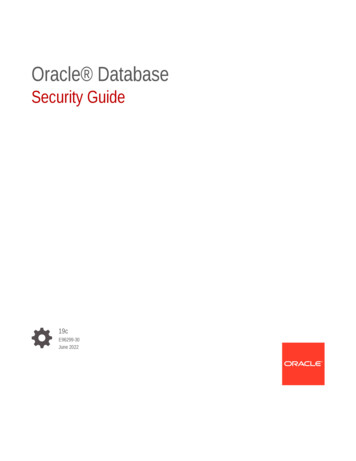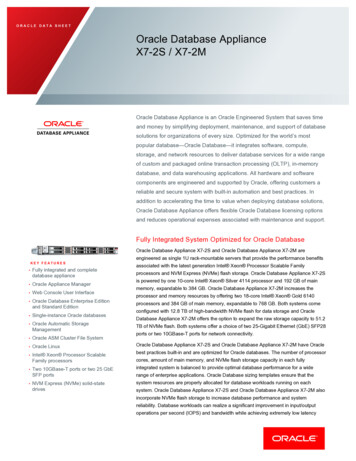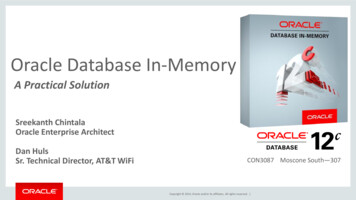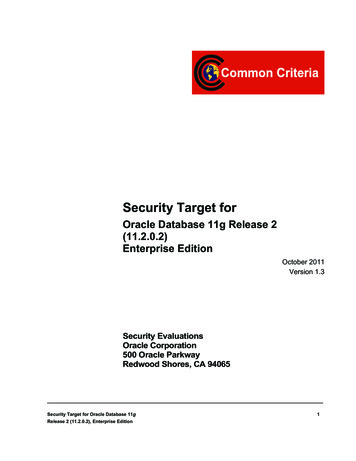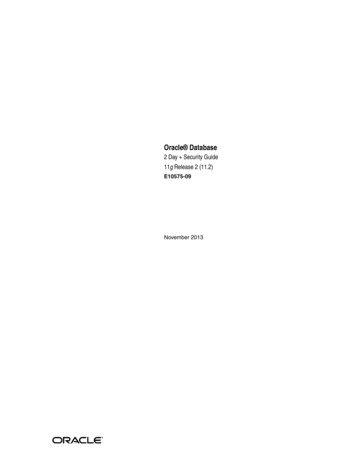
Transcription
Oracle Database2 Day Security Guide11g Release 2 (11.2)E10575-09November 2013
Oracle Database 2 Day Security Guide, 11g Release 2 (11.2)E10575-09Copyright 2006, 2013, Oracle and/or its affiliates. All rights reserved.Primary Author:Patricia HueyContributors: Naveen Gopal, Rahil Mir, Gopal Mulagund, Nina Lewis, Paul Needham, Deborah Owens,Sachin Sonawane, Ashwini Surpur, Kamal Tbeileh, Mark Townsend, Peter Wahl, Xiaofang Wang, Peter M.WongThis software and related documentation are provided under a license agreement containing restrictions onuse and disclosure and are protected by intellectual property laws. Except as expressly permitted in yourlicense agreement or allowed by law, you may not use, copy, reproduce, translate, broadcast, modify, license,transmit, distribute, exhibit, perform, publish, or display any part, in any form, or by any means. Reverseengineering, disassembly, or decompilation of this software, unless required by law for interoperability, isprohibited.The information contained herein is subject to change without notice and is not warranted to be error-free. Ifyou find any errors, please report them to us in writing.If this is software or related documentation that is delivered to the U.S. Government or anyone licensing iton behalf of the U.S. Government, the following notice is applicable:U.S. GOVERNMENT RIGHTS Programs, software, databases, and related documentation and technical datadelivered to U.S. Government customers are "commercial computer software" or "commercial technical data"pursuant to the applicable Federal Acquisition Regulation and agency-specific supplemental regulations. Assuch, the use, duplication, disclosure, modification, and adaptation shall be subject to the restrictions andlicense terms set forth in the applicable Government contract, and, to the extent applicable by the terms ofthe Government contract, the additional rights set forth in FAR 52.227-19, Commercial Computer SoftwareLicense (December 2007). Oracle America, Inc., 500 Oracle Parkway, Redwood City, CA 94065.This software or hardware is developed for general use in a variety of information managementapplications. It is not developed or intended for use in any inherently dangerous applications, includingapplications that may create a risk of personal injury. If you use this software or hardware in dangerousapplications, then you shall be responsible to take all appropriate fail-safe, backup, redundancy, and othermeasures to ensure its safe use. Oracle Corporation and its affiliates disclaim any liability for any damagescaused by use of this software or hardware in dangerous applications.Oracle and Java are registered trademarks of Oracle and/or its affiliates. Other names may be trademarks oftheir respective owners.Intel and Intel Xeon are trademarks or registered trademarks of Intel Corporation. All SPARC trademarksare used under license and are trademarks or registered trademarks of SPARC International, Inc. AMD,Opteron, the AMD logo, and the AMD Opteron logo are trademarks or registered trademarks of AdvancedMicro Devices. UNIX is a registered trademark of The Open Group.This software or hardware and documentation may provide access to or information on content, products,and services from third parties. Oracle Corporation and its affiliates are not responsible for and expresslydisclaim all warranties of any kind with respect to third-party content, products, and services. OracleCorporation and its affiliates will not be responsible for any loss, costs, or damages incurred due to youraccess to or use of third-party content, products, or services.
ContentsPreface . ixAudience.Documentation Accessibility .Related Documents .Conventions .ixixxx1 Introduction to Oracle Database SecurityAbout This Guide.Before Using This Guide .What This Guide Is and Is Not.Common Database Security Tasks.Tools for Securing Your Database .Securing Your Database: A Roadmap.2Securing the Database Installation and ConfigurationAbout Securing the Database Installation and Configuration .Using the Default Security Settings .Securing the Oracle Data Dictionary.About the Oracle Data Dictionary .Enabling Data Dictionary Protection .Guidelines for Securing Operating System Access to Oracle Database .Guideline for Granting Permissions to Run-Time Facilities.Initialization Parameters Used for Installation and Configuration Security .Modifying the Value of an Initialization Parameter uring Oracle Database User AccountsAbout Securing Oracle Database User Accounts. 3-1Predefined User Accounts Provided by Oracle Database . 3-2Predefined Administrative Accounts. 3-2Predefined Non-Administrative User Accounts . 3-5Predefined Sample Schema User Accounts. 3-6Expiring and Locking Database Accounts. 3-7Requirements for Creating Passwords. 3-8Finding and Changing Default Passwords . 3-9Guideline for Handling the Default Administrative User Passwords . 3-10iii
Guideline for Enforcing Password Management . 3-11Parameters Used to Secure User Accounts . 3-114Managing User PrivilegesAbout Privilege Management . 4-1Guideline for Granting Privileges . 4-1Guideline for Granting Roles to Users . 4-2Guideline for Handling Privileges for the PUBLIC Role . 4-2Controlling Access to Applications with Secure Application Roles. 4-2About Secure Application Roles . 4-3Tutorial: Creating a Secure Application Role . 4-4Step 1: Create a Security Administrator Account . 4-4Step 2: Create User Accounts for This Tutorial . 4-5Step 3: Create the Secure Application Role . 4-6Step 4: Create a Lookup View . 4-7Step 5: Create the PL/SQL Procedure to Set the Secure Application Role . 4-8Step 6: Grant the EXECUTE Privilege for the Procedure to Matthew and Winston. 4-10Step 7: Test the EMPLOYEE ROLE Secure Application Role. 4-10Step 8: Optionally, Remove the Components for This Tutorial . 4-11Initialization Parameters Used for Privilege Security . 4-125Securing the NetworkAbout Securing the Network .Securing the Client Connection on the Network.Guidelines for Securing Client Connections .Guidelines for Securing the Network Connection .Protecting Data on the Network by Using Network Encryption .About Network Encryption.Configuring Network Encryption .Initialization Parameters Used for Network Security.65-15-15-15-25-55-55-55-8Securing DataAbout Securing Data . 6-1Encrypting Data Transparently with Transparent Data Encryption. 6-2About Encrypting Sensitive Data . 6-2When Should You Encrypt Data? . 6-2How Transparent Data Encryption Works . 6-3Configuring Data to Use Transparent Data Encryption. 6-4Step 1: Configure the Wallet Location . 6-4Step 2: Create the Wallet . 6-5Step 3: Open (or Close) the Wallet. 6-6Step 4: Encrypt (or Decrypt) Data. 6-6Checking Existing Encrypted Data. 6-9Checking Whether a Wallet Is Open or Closed . 6-10Checking Encrypted Columns of an Individual Table. 6-10Checking All Encrypted Table Columns in the Current Database Instance . 6-10iv
Checking Encrypted Tablespaces in the Current Database Instance .Choosing Between Oracle Virtual Private Database and Oracle Label Security.Controlling Data Access with Oracle Virtual Private Database.About Oracle Virtual Private Database .Tutorial: Creating an Oracle Virtual Private Database Policy.Step 1: If Necessary, Create the Security Administrator Account .Step 2: Update the Security Administrator Account .Step 3: Create User Accounts for This Tutorial .Step 4: Create the F POLICY ORDERS Policy Function .Step 5: Create the ACCESSCONTROL ORDERS Virtual Private Database Policy .Step 6: Test the ACCESSCONTROL ORDERS Virtual Private Database Policy .Step 7: Optionally, Remove the Components for This Tutorial .Enforcing Row-Level Security with Oracle Label Security .About Oracle Label Security.Guidelines for Planning an Oracle Label Security Policy .Tutorial: Applying Security Labels to the HR.LOCATIONS Table.Step 1: Register Oracle Label Security and Enable the LBACSYS Account .Step 2: Create a Role and Three Users for the Oracle Label Security Tutorial.Step 3: Create the ACCESS LOCATIONS Oracle Label Security Policy.Step 4: Define the ACCESS LOCATIONS Policy-Level Components .Step 5: Create the ACCESS LOCATIONS Policy Data Labels.Step 6: Create the ACCESS LOCATIONS Policy User Authorizations .Step 7: Apply the ACCESS LOCATIONS Policy to the HR.LOCATIONS Table .Step 8: Add the ACCESS LOCATIONS Labels to the HR.LOCATIONS Data .Step 9: Test the ACCESS LOCATIONS Policy.Step 10: Optionally, Remove the Components for This Tutorial .Controlling Administrator Access with Oracle Database Vault .About Oracle Database Vault.Tutorial: Controlling Administrator Access to the OE Schema .Step 1: Enable Oracle Database Vault .Step 2: Grant the SELECT Privilege on the OE.CUSTOMERS Table to User SCOTT.Step 3: Select from the OE.CUSTOMERS Table as Users SYS and SCOTT .Step 4: Create a Realm to Protect the OE.CUSTOMERS Table .Step 5: Test the OE Protections Realm .Step 6: Optionally, Remove the Components for This Tutorial 86-406-416-416-426-426-456-466-476-496-497 Auditing Database ActivityAbout Auditing.Why Is Auditing Used? .Where Are Standard Audit Activities Recorded? .Auditing General Activities Using Standard Auditing.About Standard Auditing .Enabling or Disabling the Standard Audit Trail .Using Default Auditing for Security-Relevant SQL Statements and Privileges .Individually Auditing SQL Statements .Individually Auditing Privileges .Using Proxies to Audit SQL Statements and Privileges in a Multitier Environment .7-17-27-27-37-37-37-57-67-67-7v
Individually Auditing Schema Objects. 7-7Auditing Network Activity . 7-7Tutorial: Creating a Standard Audit Trail . 7-8Step 1: Log In and Enable Standard Auditing . 7-8Step 2: Enable Auditing for SELECT Statements on the OE.CUSTOMERS Table . 7-9Step 3: Test the Audit Settings. 7-10Step 4: Optionally, Remove the Components for This Tutorial . 7-11Step 5: Remove the SEC ADMIN Security Administrator Account . 7-11Guidelines for Auditing . 7-12Guideline for Using Default Auditing of SQL Statements and Privileges . 7-12Guidelines for Managing Audited Information . 7-12Guidelines for Auditing Typical Database Activity . 7-13Guidelines for Auditing Suspicious Database Activity. 7-13Initialization Parameters Used for Auditing . 7-14Indexvi
List of 16–27–1Default Security Settings for Initialization and Profile Parameters. 2-2Initialization Parameters Used for Installation and Configuration Security . 2-5Predefined Oracle Database Administrative User Accounts . 3-2Predefined Oracle Database Non-Administrative User Accounts . 3-5Default Sample Schema User Accounts. 3-7Initialization and Profile Parameters Used for User Account Security . 3-12Initialization Parameters Used for Privilege Security . 4-12Initialization Parameters Used for Network Security . 5-8Data Dictionary Views for Encrypted Tablespaces . 6-11Comparing Oracle Virtual Private Database with Oracle Label Security . 6-12Initialization Parameters Used for Auditing . 7-14vii
viii
PrefaceWelcome to Oracle Database 2 Day Security Guide. This guide is for anyone who wantsto perform common day-to-day security tasks with Oracle Database.This preface contains: Audience Documentation Accessibility Related Documents ConventionsAudienceOracle Database 2 Day Security Guide expands on the security knowledge that youlearned in Oracle Database 2 Day DBA to manage security in Oracle Database. Theinformation in this guide applies to all platforms. For platform-specific information,see the installation guide, configuration guide, and platform guide for your platform.This guide is intended for the following users: Oracle database administrators who want to acquire database securityadministrative skillsDatabase administrators who have some security administrative knowledge butare new to Oracle DatabaseThis guide is not an exhaustive discussion about security. For detailed informationabout security, see the Oracle Database Security documentation set. This guide doesnot provide information about security for Oracle E-Business Suite applications. Forinformation about security in the Oracle E-Business Suite applications, see thedocumentation for those products.Documentation AccessibilityFor information about Oracle's commitment to accessibility, visit the OracleAccessibility Program website athttp://www.oracle.com/pls/topic/lookup?ctx acc&id docacc.Access to Oracle SupportOracle customers have access to electronic support through My Oracle Support. Forinformation, visithttp://www.oracle.com/pls/topic/lookup?ctx acc&id info or visitix
http://www.oracle.com/pls/topic/lookup?ctx acc&id trs if you arehearing impaired.Related DocumentsFor more information, use the following resources:Oracle Database DocumentationFor more security-related information, see the following documents in the OracleDatabase documentation set: Oracle Database 2 Day DBA Oracle Database Administrator's Guide Oracle Database Security Guide Oracle Database Concepts Oracle Database Reference Oracle Database Vault Administrator's GuideMany of the examples in this guide use the sample schemas of the seed database,which is installed by default when you install Oracle. See Oracle Database SampleSchemas for information about how these schemas were created and how you can usethem.Oracle Technology Network (OTN)You can download free release notes, installation documentation, updated versions ofthis guide, white papers, or other collateral from the Oracle Technology Network(OTN). or security-specific information on OTN, rity/whatsnew/index.htmlFor the latest version of the Oracle documentation, including this guide, on/index.htmlOracle Documentation Search EngineTo access the database documentation search engine directly, visithttp://tahiti.oracle.com/My Oracle Support (formerly OracleMetaLink)You can find information about security patches, certifications, and the supportknowledge base by visiting My Oracle Support athttps://support.oracle.comConventionsThe following text conventions are used in this document:x
ConventionMeaningboldfaceBoldface type indicates graphical user interface elements associatedwith an action, or terms defined in text or the glossary.italicItalic type indicates book titles, emphasis, or placeholder variables forwhich you supply particular values.monospaceMonospace type indicates commands within a paragraph, URLs, codein examples, text that appears on the screen, or text that you enter.xi
xii
1Introduction to Oracle Database Security1This chapter contains: About This Guide Common Database Security Tasks Tools for Securing Your Database Securing Your Database: A RoadmapAbout This GuideOracle Database 2 Day Security Guide teaches you how to perform day-to-daydatabase security tasks. Its goal is to help you understand the concepts behind OracleDatabase security. You will learn how to perform common security tasks needed tosecure your database. The knowledge you gain from completing the tasks in OracleDatabase 2 Day Security Guide helps you to better secure your data and to meetcommon regulatory compliance requirements, such as the Sarbanes-Oxley Act.The primary administrative interface used in this guide is Oracle Enterprise Managerin Database Console mode, featuring all the self-management capabilities introducedin Oracle Database.This section contains the following topics: Before Using This Guide What This Guide Is and Is NotBefore Using This GuideBefore using this guide: Complete Oracle Database 2 Day DBAObtain the necessary products and tools described in "Tools for Securing YourDatabase" on page 1-2What This Guide Is and Is NotOracle Database 2 Day Security Guide is task oriented. The objective of this guide is todescribe why and when you must perform security tasks.Where appropriate, this guide describes the concepts and steps necessary tounderstand and complete a task. This guide is not an exhaustive discussion of allOracle Database concepts. For this type of information, see Oracle Database Concepts.Introduction to Oracle Database Security1-1
Common Database Security TasksWhere appropriate, this guide describes the necessary Oracle Database administrativesteps to complete security tasks. This guide does not describe basic Oracle Databaseadministrative tasks. For this type of information, see Oracle Database 2 Day DBA.Additionally, for a complete discussion of administrative tasks, see Oracle DatabaseAdministrator's Guide.In addition, this guide is not an exhaustive discussion of all Oracle Database securityfeatures and does not describe available APIs that provide equivalent command linefunctionality to the tools used in this guide. For this type of information, see OracleDatabase Security Guide.Common Database Security TasksAs a database administrator for Oracle Database, you should be involved in thefollowing security-related tasks: Ensuring that the database installation and configuration is secureManaging the security aspects of user accounts: developing secure passwordpolicies, creating and assigning roles, restricting data access to only theappropriate users, and so on Ensuring that network connections are secure Encrypting sensitive data Ensuring the database has no security vulnerabilities and is protected againstintrudersDeciding what database components to audit and how granular you want thisauditing to beDownloading and installing security patchesIn a small to midsize database environment, you might perform these tasks as welland all database administrator-related tasks, such as installing Oracle software,creating databases, monitoring performance, and so on. In large, enterpriseenvironments, the job is often divided among several database administrators—eachwith their own specialty—such as database security or database tuning.Tools for Securing Your DatabaseTo achieve the goals of securing your database, you need the following products, tools,and utilities: Oracle Database 11g Release 2 (11.2) Enterprise EditionOracle Database 11g Release 2 (11.2) Enterprise Edition provides enterprise-classperformance, scalability, and reliability on clustered and single-serverconfigurations. It includes many security features that are used in this guide. Oracle Enterprise Manager Database ControlOracle Enterprise Manager is a Web application that you can use to performdatabase administrative tasks for a single database instance or a clustereddatabase. SQL*PlusSQL*Plus is a development environment that you can use to create and run SQLand PL/SQL code. It is part of the Oracle Database 11g Release 2 (11.2) installation. Database Configuration Assistant (DBCA)1-2 Oracle Database 2 Day Security Guide
Securing Your Database: A RoadmapDatabase Configuration Assistant enables you to perform general database tasks,such as creating, configuring, or deleting databases. In this guide, you use DBCAto enable default auditing. Oracle Net ManagerOracle Net Manager enables you to perform network-related tasks for OracleDatabase. In this guide, you use Oracle Net Manager to configure networkencryption.Securing Your Database: A RoadmapTo learn the fundamentals of securing an Oracle database, follow these steps:1.Secure your Oracle Database installation and configuration.Complete the tasks in Chapter 2, "Securing the Database Installationand Configuration" to secure access to an Oracle Database installation.2.Secure user accounts for your site.Complete the tasks in Chapter 3, "Securing Oracle Database User Accounts",which builds on Oracle Database 2 Day DBA, where you learned how to create useraccounts. You learn the following:3. How to expire, lock, and unlock user accounts Guidelines to choose secure passwords How to change a password How to enforce password managementUnderstand how privileges work.Complete the tasks in Chapter 4, "Managing User Privileges". You learn about thefollowing:4. How privileges work Why you must be careful about granting privileges How database roles work How to create secure application rolesSecure data as it travels across the network.Complete the tasks in Chapter 5, "Securing the Network" to learn how to secur
Oracle database administrators who want to acquire database security administrative skills Database administrators who have some security administrative knowledge but are new to Oracle Database This guide is not an exhaustive discussion about security. For detailed information about security, see the Oracle Database Security documentation set.
